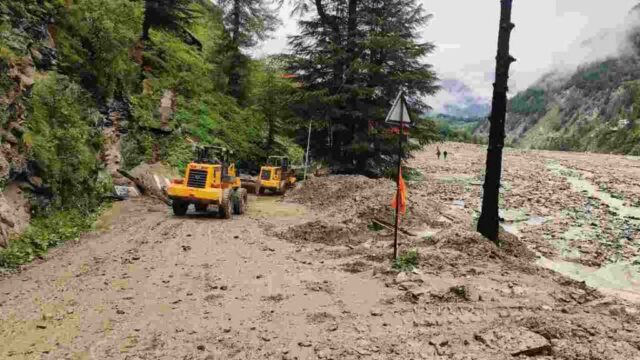What would happen if there was no ice left in the Arctic

The initial report of the biggest experiment on Earth’s environment has come. The size of this report, prepared around the North Pole in the Arctic Ocean for a total of 389 days from September 2019 to October 2020, is so large that it will take many years to come out with all its findings. But German scientist Markus Rex, the leader of the team of more than 300 people who completed it, presented a rough blueprint of his experiment with slideshows and video on June 15 in Berlin. He told that the environmental crisis of the Arctic region has become uncontrollable.
shortened arctic circle
Giving evidence of the extent of the maximum deposition of the Arctic Ocean in the last one century and the thickness of its ice has halved in the last three decades, Dr. Rex also said that by the year 2050, if the carbon emissions on the earth are not brought down to zero. If possible, the next generation will have to see the Arctic without ice. What this means for people like us who have nothing to do with the polar regions will be discussed further. At present, returning to this campaign of scientists from twenty countries, which was run by investing $ 160 million, an icebreaker ship named Polarstern was used in it, to which some Russian ships kept coming and going in between.
In the place which was initially thought for this work, the ice layer was found very thin. The ship was then propelled further into the thick ice to provide a stable surface within 40 km of the ship, from which to record day-to-day changes in wind, ice and water below. Mind you, the purpose of this study was not limited to increasing the understanding of an under-understood region of the Earth. According to the information till now, the earth is the only living body of the entire creation. If we look at it like a living thing, then the Arctic region can be considered as its head or brain. Unfortunately, the one region where the Earth’s environment is most disturbed is the Arctic.
Geographically, the line of latitude 66°33 is called the Arctic Circle, while meteorologists define it as the isotherm where the temperature does not exceed 10°C in July. This line is also the tree line of the earth, that is, there are no trees to its north. Global warming has trashed this definition in the sense that over the past three decades, the line with a maximum temperature of 10 °C has been moving north at a speed of 56 km per decade. That is, human interference in the environment is shrinking the Arctic Circle day by day.
From a geopolitical point of view, in addition to the Arctic Ocean and the many seas that surround it (Norwegian, Barents, Kara, Laptev, East Siberian, Chukchi, Beaufort, Baffin Bay, Davis Bay, Denmark Gulf and Greenland Sea), Sweden, Norway, Finland, Russia, America (Alaska), Canada, Greenland and Iceland cover a large area of the mainland and many of their islands fall within the Arctic Circle.
The linguistic origin of the word arctic is from the Greek word arctos (bear). The Greek explorer Pythias, a contemporary of Alexander, mentions the curd-like sea, the midnight sun and mysterious lights (aurora borealis) in his adventures to the north. It is clear from these descriptions that Pythias of Masalia had reached the Arctic Circle in 325 BC. But two things are in vogue regarding the relationship of this area with the bear. One is that in the name of living things, only giant white bears are seen here, which are not found anywhere else in the world. The second classical theory is that the constellations Ursa Major (Saptarshi) and Ursa Minor appear exactly head-on in the Arctic Circle. Arctos in Greek, Ursa in Latin and Riksha or Rishi in Sanskrit, all three mean bear or bear.
The idea of seeing the Arctic as the brain of the Earth is not just because it looks over the globe. The Arctic has an important role in determining the nature of the ocean and wind waves that drive the rain cycle in every region of the planet. The problem is that the impact of global warming is being felt on the Arctic region more than it is visible on the rest of the earth. The average temperature of the rest of the world is currently being recorded 1 degree Celsius higher than in 1900, but in the Arctic region this increase is of 2 degrees. The reduction in the ice cover here means the darkening of a huge mirror that returns the sun’s heat and the speed of global warming suddenly increases. Apart from this, there is also a vicious circle of ice and less freezing in the next winter due to the absorption of heat by the emptied seas.
Polar Bears will end
During this experiment, every moment changes in 100 parameters from the air above two kilometers to the water below all the ice were recorded throughout the year. Along with 1000 samples of ice were also taken, on which work is going on. Both zooplankton, the smallest animal in the water and phytoplankton, the smallest plant, where the marine food chain begins, were studied. The chain runs from prawns and small fish to seal-walruses and polar bears at the top of the Arctic food chain. Marcus Rex and his team predict that this food chain could break sometime after 2035. It has to be called the massacre of the polar bears, to which the identity of this vast area of Earth is attached. Its effect on our seasons is just beginning to be seen. Based on the data obtained from this experiment,
Chandrabhushan







